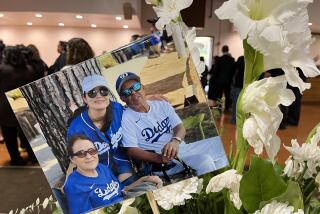For Action Photographs, Make Split-Seconds Count
- Share via
Many amateur photographers think that if they had the correct motor drives and lenses they could get the same great action photographs they see in magazines and newspapers.
It just isn’t the case.
If you rely on a motor drive, even at a speed of six frames a second, it isn’t fast enough to get the right shot. You have to shoot selectively and make the first frame count.
V.J. Lovero’s job is to make that split-second count. Lovero, 30, is the staff photographer for the California Angels and also shoots for Sports Illustrated. In addition, he recently added Upper Deck, a baseball card company, to his list of regular clients.
Lovero has shot several unusual cover photos for the Angels program, such as Wally Joyner at Disneyland, Mike Witt with King Kong at Universal Studios, Gary Pettis standing next to a fighter jet at March Air Force Base, Bob Boone in a blacksmith shop at Knott’s Berry Farm and Brian Downing with Arnold Schwarzenegger at World Gym in Santa Monica.
Lovero, born and reared in Santa Ana, started shooting photographs in his freshman year at Santa Ana Valley High School. He also attended Orange Coast College and Cal State Fullerton. His entry into baseball came after shooting photographs of former Angel Rod Carew for a public relations firm in 1982.
He was a free-lance photographer for the Angels for two years before joining the staff in 1984. His first assignment for Sports Illustrated was in 1985 and since then his work has appeared in Time, Life, Newsweek, Sport, Inside Sports, Sporting News and Fortune.
Lovero says the key to good action photography is practice.
“If you are at a game, focus on everything you see as if you are going to shoot it,” he said. “Don’t waste film (following a runner down the base line) but follow-focus as he runs.
“If you focus on someone who’s moving and you have a 600-millimeter lens, you have to be perfectly accurate. There is no depth-of-field. You could focus on a man’s nose and the back of his ears will be out of focus. It’s either in focus or out; there is no in-between. Smaller lenses with more depth-of-field are far more forgiving.”
Lovero has a few tips for those interested in improving their sports photography.
Start by shooting lower-level baseball such as college, high school or Little League. You can get closer to the action and you have more freedom to move around and shoot where you want.
Since most amateurs don’t have access to long focal-length lenses, positioning is very important. You don’t want to be sitting in the last rows at Anaheim Stadium with a 200-millimeter lens.
Knowing the game. Pay attention to the flow of the game. Baseball can lull you into a daze and your pictures won’t be sharp.
Use a monopod on lenses that are 300-millimeter or longer. Some 300 lenses may seem light enough to hand hold, but you usually experience camera movement when you press the shutter. A monopod gives you more freedom of movement than a tripod. Even though you are stationary, you may want to move the camera to the extreme right or left and a monopod is better for that situation. In addition, a monopod gives you more freedom of movement should the action get too close to you.
If you are shooting through a fence, move as close as you can to the fence. Also shoot through a shady spot. Chain-links that are highlighted by the bright sun may cause a haze or refection in your photograph.
Try and shoot baseball at 1/500th of a second or faster. There isn’t a good time to shoot slower unless the player is completely stationary.
Baseball action can happen very quickly, so anticipate where the play will be and focus on that location. Figure out what’s going to happen before it happens.
Be aware of the baseball at all times. It’s very important, because a baseball isn’t going to miss you just because you are a photographer.
More to Read
Go beyond the scoreboard
Get the latest on L.A.'s teams in the daily Sports Report newsletter.
You may occasionally receive promotional content from the Los Angeles Times.







